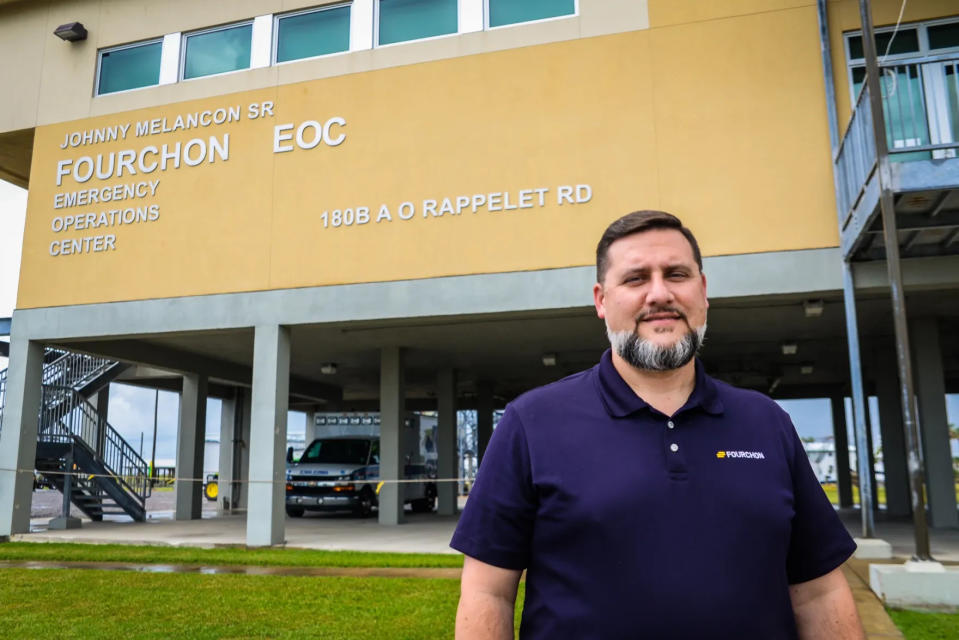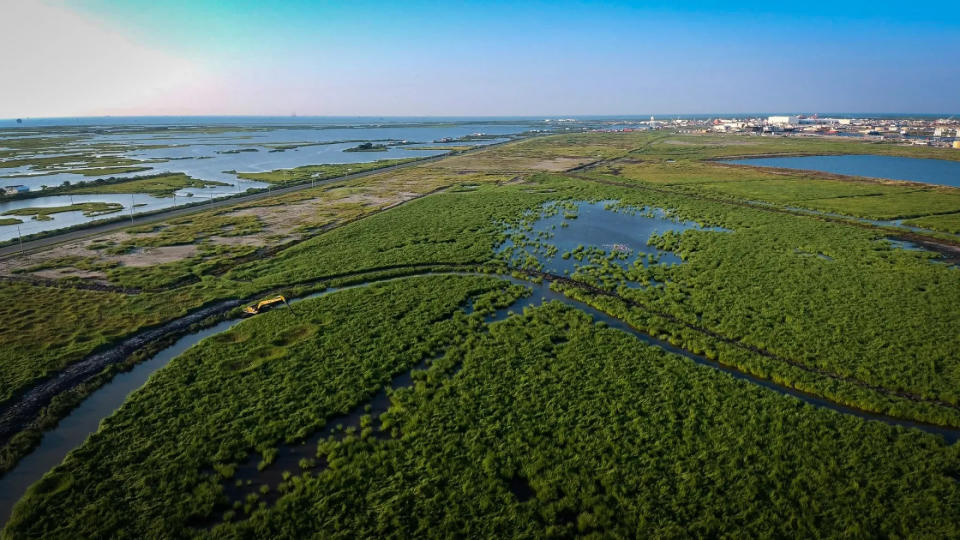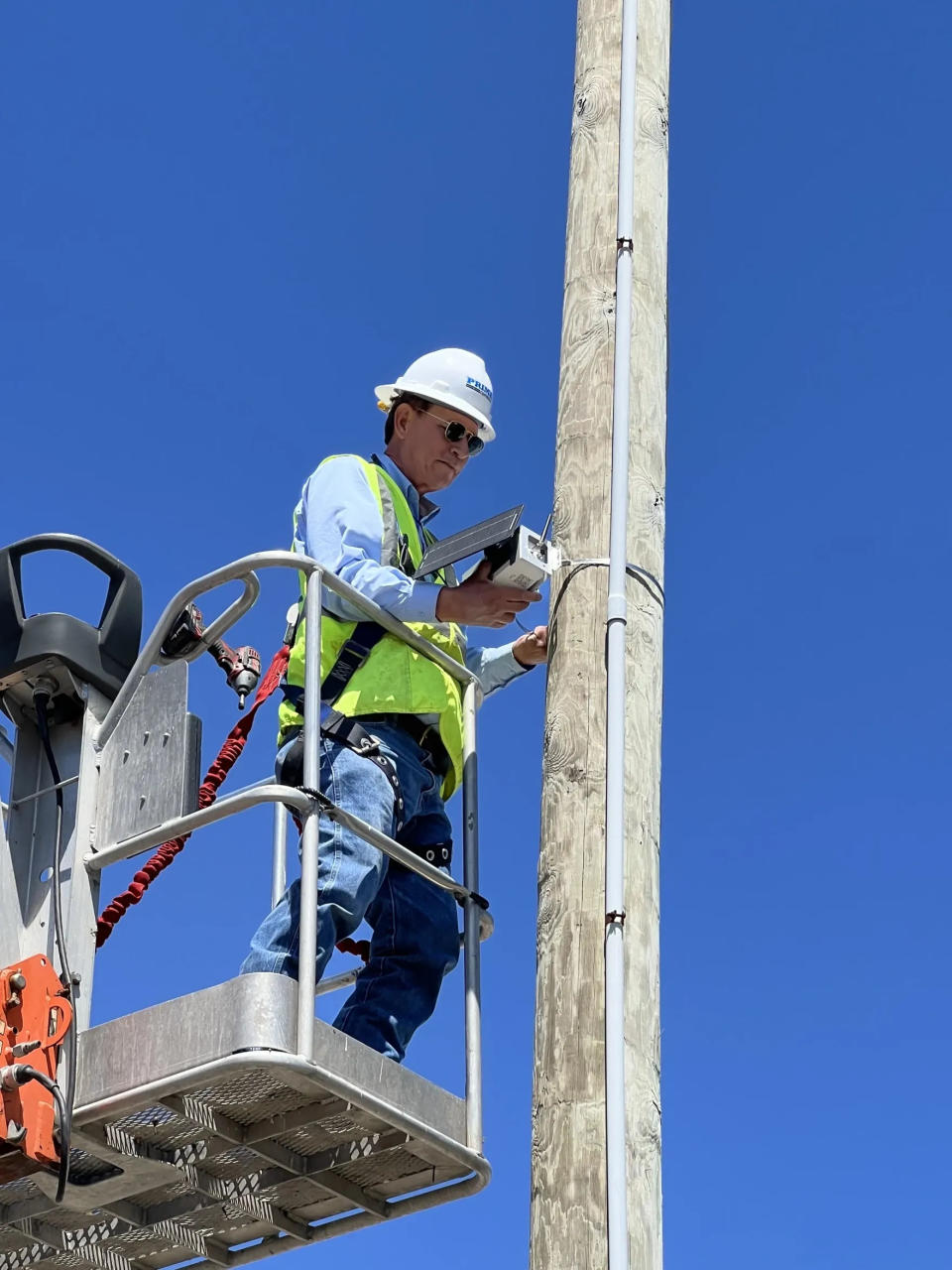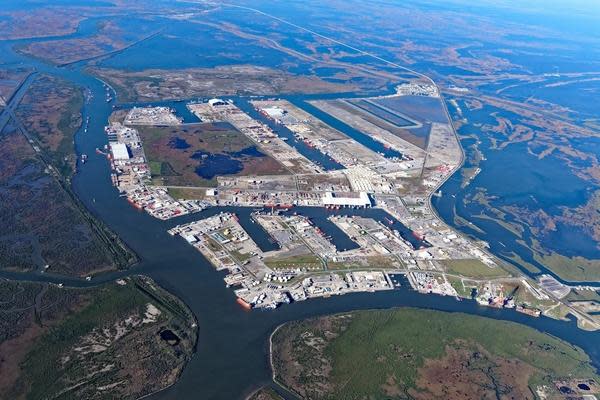Oil and gas built Port Fourchon. Now the port is finding its role in a future without it.
Travel south to where Louisiana’s land gives way to the sea, and then keep going. It might feel like you’re driving to the end of the world, traveling across a tall, winding bridge above broken marsh to reach the state’s southernmost port.
Upon arrival, you’re first greeted by elevated fishing camps before passing a long stretch of marsh built with dredging. Beyond that lies the industry, the port’s customers. Massive warehouses and wide slips hold large ocean-faring ships. Towering storage tanks hold fuel and water for the vessels to carry to oil and gas platforms miles offshore.
As one of the country’s premier oil and gas seaports, Port Fourchon, at the southern tip of Lafourche Parish, plays an essential role in maintaining one-sixth of the nation's oil supply. Its clients serve 95% of the Gulf of Mexico’s oil and gas production. But the port is also increasingly threatened by global warming, driven in large part by the industries it serves.

That was evidenced by Hurricane Ida. Nearly a year later, the storm’s damage remains clearly visible. Some warehouses have yet to be repaired, and wooden wharves sit broken. The port’s 1,700 acres sit right on the Gulf, making it the first to feel the effects of worsening hurricanes and accelerated sea level rise. That’s on top of coping with the state’s ongoing land-loss crisis.
Previous coverage: New park at Port Fourchon offers kayakers a place to paddle
Read this: Will Louisiana lead energy transition or be left behind? Universities pivot programs to lead
The environment surrounding the oil-and-gas port is personal to Executive Director Chett Chiasson and much of the port's staff. It’s where they grew up. Chiasson himself is a Larose native who now lives about 30 miles north of Fourchon in Cut Off. He’s witnessed the coast erode.
Watching wetlands wash away

“I'm 45. I've watched it, for 45 years, wash away,” Chiasson said. “Although we are very pro-industry and pro-energy, we're environmentalists because we grew up that way.”
Their connection to the local wetlands drove them to build more with sediment they dredged to maintain the port, bolstering the habitat around for local species and flood protection. Now, for the first time, they’ve begun thinking about their industry’s role in climate change, and they’re reimagining the port’s future as the world looks to transition away from fossil fuels.
That starts with being transparent about greenhouse gas emissions, reports that have long been lacking in the maritime industry.
Globally, the maritime industry is responsible for about 3% of all planet-warming emissions, according to estimates from the International Maritime Organization. But industry experts said greenhouse gas emissions weren’t a consideration on ships, something that’s only begun to change in the past decade.
Port Fourchon is one of the first seaports in the U.S. to begin filling in the information gaps.
Testing the air

Four months ago, the staff installed sensors across the port to conduct real-time air monitoring, track emissions at different locations and see their origin.
Chiasson said the port is still gathering that data and has yet to set any firm goals for reducing carbon emissions. A plan will come in time, and SailPlan, the same company that installed the sensors, will also help.
“Before you start optimizing, you’ve got to understand your problem, and the opportunities to optimize what you can fix and what you can't fix,” said Jacob Ruytenbeek, the company’s founder.
'A bad situation': More climate action needed to curb Louisiana, U.S. emissions goal by 2030
Terrebonne Bay oil spill: Oil spill in Terrebonne Bay on opening day of shrimp season causes grief for fishermen
Dan Hubbell, who focuses on shipping emissions for the Ocean Conservancy, said air monitors still aren’t widely used by the maritime industry. Instead, companies rely on estimates based on how much fuel their ships use, which often leads to undercounting.
Ruytenbeek said the industry faces increasing pressure to lower emissions after neglecting for decades to do any tracking. And the oil-and-gas industry that Port Fourchon’s clients serve faces similar pressure.
If offshore service companies show they’re lowering their footprint, they become attractive to bigger oil-and-gas companies. And seaports like Fourchon can help their customers do it.
Going electric

Within the port itself, cutting carbon emissions means electrifying things when possible, from the vehicles and equipment the port uses to building electrical hookups for the ships themselves to use when docked. That option – to use “shore power" – came online at Fourchon two years ago through a partnership with Entergy Corporation.
“That's the first thing on my mind that would lower emissions is by having everyone, as soon as they get in, plug in. Don't use your generators,” Chiasson said.
One study published earlier this year by the University Marine Advisory Services suggested Fourchon in particular would be one of the best ports to start electrifying due to several factors, including its customers’ shipping routes and high fuel consumption. Some companies have opted in, but Chiasson said the port hasn’t mandated it. Instead, port officials are starting to look at ways to incentivize it or help pay for the installation.
Hubbell, with the Ocean Conservancy, noted ports and companies could take that even further by possibly crafting mobile charging stations to send to ships idling offshore.
For the ships themselves, emissions will be difficult to eliminate until alternative, zero-carbon fuels like hydrogen or ammonia become available.
Dig deeper: 5 big questions about the new Biden plan for offshore oil and gas leases
Related: Biden oil proposal could allow up to 10 lease sales in Gulf. Or maybe not.
Getting started

A few have already started to lower their emissions, like Harvey Gulf. The offshore marine supply company works out of Port Fourchon and owns five ships that run off a mix of renewable liquefied natural gas — typically collected from landfills or farms where the decomposing material creates methane — and battery power.
They’re also some of the first U.S. supply boats to have real-time monitors installed on their ships' stacks to track their emissions and run more efficiently, saving their customers money on fuel.
“It makes my vessel more marketable,” said Chad Verret, Harvey Gulf’s executive vice president for LNG operations. Increased efficiency also lowers upkeep costs.
LNG burns cleaner than traditional diesel engines, Verret said, while the company waits for other fuels to come online. When that happens, Hubbell noted that ports will have a role in ensuring the infrastructure is available on-site for ships to refuel using hydrogen or ammonia.
Winds of change
Meanwhile, Port Fourchon stands on the precipice of a new economic driver: offshore renewable energy. The same companies serving the Gulf’s oil-and-gas industry have the tools to build massive wind farms aimed at replacing the country’s reliance on fossil fuels for power.
“Offshore wind is real. I believe we could see a project coming in a couple of years,” Chiasson said. “I didn't think it was gonna be this quick and this much interest, … but that industry is taking notice of Fourchon.”
The wind giants that started building on the East Coast are already familiar with Fourchon’s customers, and now they’re coming south. As oil and gas are phased out, that means offshore wind could enhance the long-term viability of companies created with the fossil fuel industry in mind — and spur a rebrand.
“We're changing that narrative to be: we are in an energy service port,” Chiasson said. “Whatever energy that is, that's what we're gonna be involved in.”
— Courier and Daily Comet Executive Editor Keith Magill can be reached at 857-2201 or keith.magill@houmatoday.com. Follow him on Twitter @CourierEditor.
This article originally appeared on Daily Comet: Port Fourchon charts course as world shifts away from oil and gas
